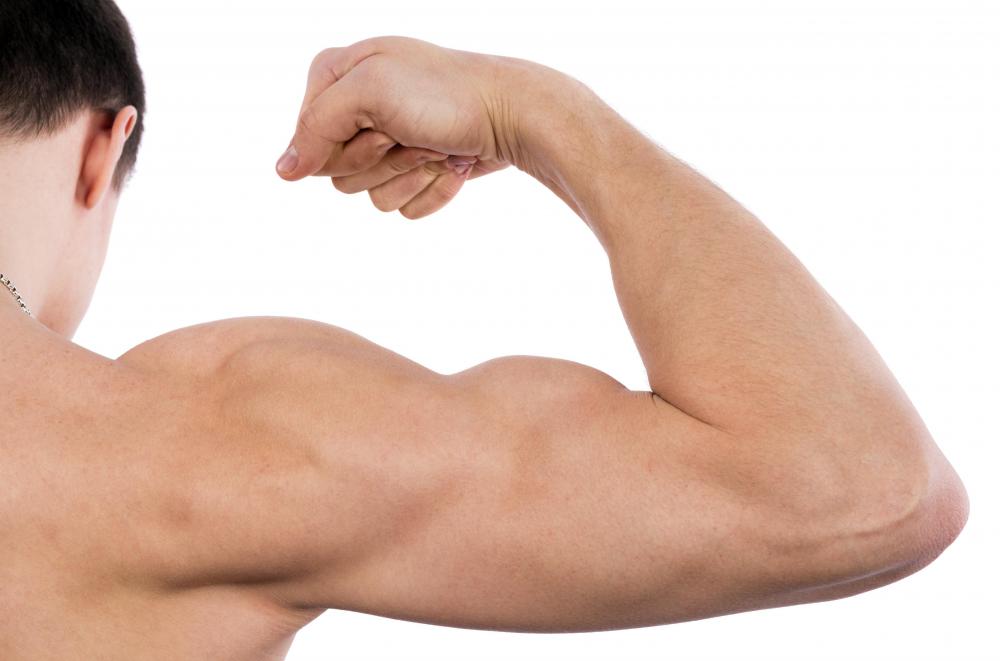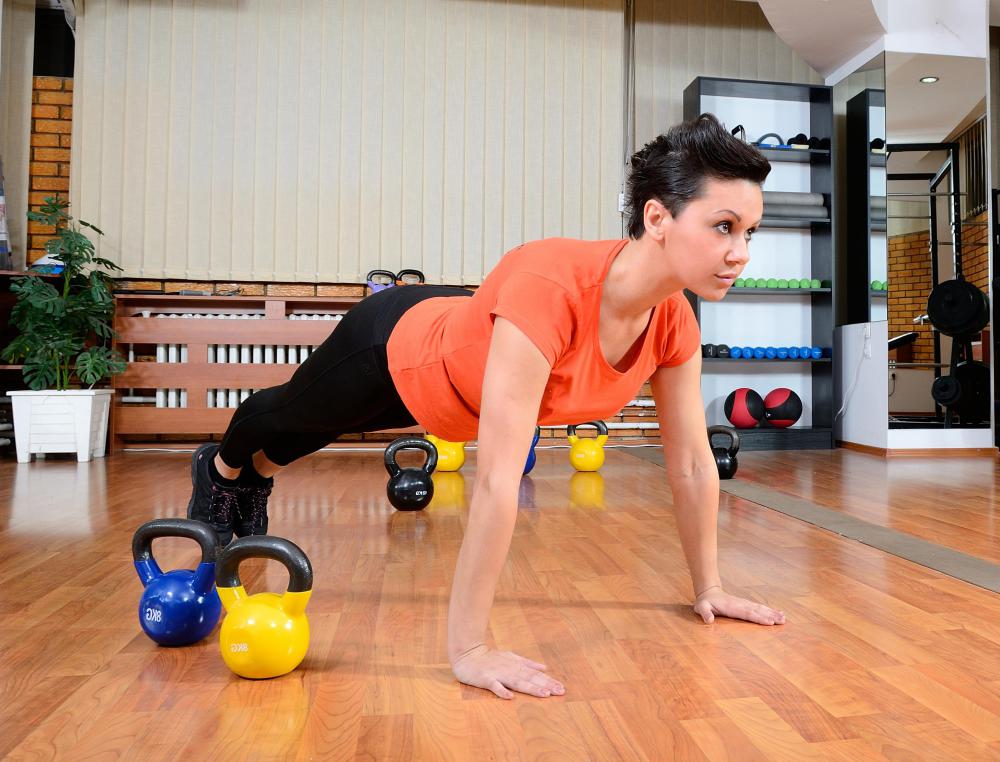At TheHealthBoard, we're committed to delivering accurate, trustworthy information. Our expert-authored content is rigorously fact-checked and sourced from credible authorities. Discover how we uphold the highest standards in providing you with reliable knowledge.
What Are Delts In Shoulders?
The deltoid muscles, or delts, are the groups of muscles capping the shoulder. Each deltoid consists of three distinct muscle groups or heads: the anterior, posterior and lateral deltoids. These muscles are responsible for working the shoulder joint, moving the arm away from the body in all directions and providing strength and stability to the shoulder.
Delts are shaped like triangles curving over each shoulder. In fact, the name is derived from delta, the Greek word for a triangle. Each of the deltoid heads is anchored to a different point on the torso, with the anterior connected to the collarbone and the posterior and lateral fixed to the different portions of the shoulder blade. All three come together at the upper portion of the humerus and create a distinct V shape on the upper arm.

Each of these deltoid heads is responsible for lifting the arm in one specific direction. Anterior deltoids give the arm forward motion, posterior deltoids pull the arm backward, and lateral deltoids a move the arm to the side. Working in tandem, the delts give the arm the ability to stretch up and out from the body at any angle. With the help of other upper-body muscle groups, deltoids add to the shoulder’s range of motion, allowing it to shrug, drop and rotate.

Deltoids also are responsible for holding the shoulder together and minimizing damage. When one is carrying a heavy load, the delts bear that weight and prevent the load from pulling the humerus out of its socket. In cases where objects need to be held away from the body, such as with a sloshing bucket, the deltoids are able to raise these loads laterally.

Developed deltoids give the upper body a broader, more imposing silhouette, and exercises focused on the deltoids are popular among bodybuilders and other athletes. Bodybuilders must keep in mind the function of each portion of the delts for a balanced physique. Focusing on a single range of motion will develop only a third of the deltoid muscles. Exercises working each of the deltoid heads must be selected to develop the entire muscle group.

Workouts targeting the delts most often involve weightlifting. Deltoid workouts commonly include variations on military presses, lateral raises and front raises. Any motion of the shoulder will, however, work a portion of the deltoids, and expensive gym equipment is not required. Simple push-ups or chin-ups will give the shoulders an excellent workout.
Injuries To the Delts
The deltoid muscles are used a lot in daily movement. Since people repetitively move their arms and use their shoulders to carry and lift heavy objects, someone can get injured at any time. Here are some of the most common causes of injuries.
Sports and Overuse
Participating in certain sports, such as swimming and weightlifting, and repeatedly making the same motions, like picking up children, causes a lot of strain on the shoulder muscles. These activities cause the majority of deltoid injuries.
Auxillary Nerve Problems
The group of nerves in the shoulder and neck area are called the auxiliary nerves. Inflammation, injury and systemic conditions may cause the nerves not to work correctly. This can cause weakness or numbness in the deltoid and other shoulder muscles.
Injury
Slipping and landing on the shoulder, being in a car accident or catching a heavy object may all cause injury to the deltoid muscles. Sometimes the pain is sudden, but occasionally the damage may not surface until after the adrenaline wears off.
Symptoms of a Deltoid Strain
The most common type of injury to the deltoid muscle is a strain. A muscle tear or stretch in one of the delts may occur due to overuse, repetitive motion or an accident such as a fall. The following symptoms may indicate injury to the delts.
- A popping noise or tearing sensation may be heard or felt during an injury.
- A sharp, sudden pain may result from a deltoid strain. Sometimes the pain only affects the shoulder during movement, while other times, the injury is so extreme that a person feels discomfort while the shoulder isn’t moving.
- Loss of muscle control or weakness may indicate an injury.
- Bruising and swelling may take a few days to appear or may show up immediately after an injury.
- The muscle may appear red and feel hot to the touch.
- Limited range of motion and stiffness is typical in a strain.
- Muscles spasms may result from an injury to the delts.
Diagnosis of the Injury

A doctor should diagnose any suspected injuries and strains. A physician reviews a person’s medical history, discusses how the damage happened, and does a physical exam of the shoulder. A doctor may use an MRI, CT scan, or X-rays to confirm a diagnosis for severe injuries.
Extent of Injury
A doctor classifies this type of injury into three categories based on the extent of the damage.
Grade 1
People with a minor sprain of this grade may not have any swelling and only slight pain and tightness. Only about 10% of the muscle fibers are affected by a small tear. They should be able to continue using their arm and shoulder without too much difficulty and return to regular use within ten days.
Grade 2
This mid-grade injury causes more swelling and tightness and limits the range of motion in the muscle. Lifting the shoulder in any direction or performing weight-bearing exercises may be painful. Damage may affect approximately 50% of the muscle fibers at this level, and recovery can take up to six weeks.
Grade 3
The most severe strain may make it almost impossible to move the shoulder in any direction. A complete tear of over 90% of the deltoid may have symptoms such as a muscle bulge or gap and severe swelling and bruising. The shoulder may need to remain immobilized from up to 30 days, with total recovery taking three to four months.
Pain Management
A deltoid strain can negatively impact a person’s daily life. Fortunately, there are a few different ways to manage the pain and discomfort caused by this injury.
- Apply an ice pack intermittently during the first 24 hours after an injury to reduce pain and swelling.
- Take over-the-counter pain medication to decrease swelling and make the discomfort more manageable.
- Rest the shoulder after a minor injury to prevent further damage and irritation.
- Use a heating pad to loosen stiff deltoid muscles.
- Begin with light exercises when returning to workouts or sports.
- Attend physical therapy sessions for a more severe injury.
Prevent Further Injuries
While accidents happen without warning, some injuries may be preventable. Warming up before and after exercising or playing sports prevents damage to the delts. It’s also essential to keep your muscles strong with routine workouts and alternate the exercises to give your delts time to recover. People who work in an industry that requires a lot of heavy lifting over their heads should wear the appropriate safety equipment to prevent hurting themselves.
AS FEATURED ON:
AS FEATURED ON:















Discussion Comments
@manykitties2 - You really don't need to worry about bulking up. If you don't take any supplements to get big, don't worry! Women just don't have the right body composition to get huge like men do.
I do rear delt exercises as part of my regular upper body workout and I find it helps with my back strength. You need to focus on all of your muscles at one point or another because you want to have a balanced workout.
If you are worried about rear delt exercises on the machine you can ask one of the trainers at the gym how to do a rear delt raise or the rear delt row with free weights. These exercises do a great job of shaping you up without bulking you up.
I have been looking at some different weight machines at the gym and was wondering if working on something like the rear delt machine would be a good idea for a woman?
I really want to have shapely arms and a good body line, but I don't want to accidentally build up the wrong muscles and look too wide. I was always under the impression that the rear delts were more of something men should work on, but I want a balanced workout and to improve my general strength. I know I have seen some women using the rear delt machine so I am willing to give it a try if it will help me look better.
There are lots of great delt exercises that you can do in the comfort of your own home without a single piece of equipment. The value of body weight exercises varies depending on the muscle group you are trying to engage, but delts are one of the easiest to build up using just your own body.
Of course there is the classic pushup. This can be modified in many ways to put more strain and dynamic tension on the shoulder muscles. You can also do pushups with your legs in the air balanced against a wall. This is kind of like a reverse pull up and it blasts the whole upper body. Finally, take a heavy container of detergent and raise it up using only your shoulder muscles. Do this straight out in front, to the side and every angle in between. This will add a lot of mass and develop the muscle at every point of stress.
Building up your delts is one of the best ways to add strength and mass for any guy looking to bulk up. Not only are the delts one of the larger muscle groups in the body, but their placement at the shoulders means that any time they grow it increases the width of your upper body. Building up your deltoids is key if you want to develop that V shaped look that is so in demand amongst men these days.
Luckily, the shoulder muscles are easy to develop because they can engage is a wide range of motion and they are used almost any time you engage your upper body. Even if you never worked out your delts specifically, they would grow in the course of a normal workout routine just by necessity. But if you are looking for faster and bigger results there are lots of great shoulder exercises that you can do. Consult with a trainer or look up info online.
Post your comments